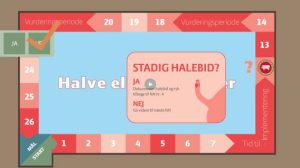Abstract: Risk Assessment Tool and Indicator Pens
Type and Average of Pigs on the Farm
The farm maintains approximately 600 sows, 2,800 weaners, and 150 grower-finishers.

Farming System
The production system is intensive, with no use of extensive, organic, or free-range methods.
Description and Evaluation of the Good Practice
The Risk Assessment Tool was developed to support farmers in managing pigs with undocked tails. It identifies potential risk factors for tail biting and provides recommendations for optimal conditions in areas such as water, feed, rooting material, climate, health, and management. The tool includes a checklist that can be used on-farm to systematically evaluate these factors. An action plan component allows farmers to document identified risks, assign responsibilities, and set timelines for mitigation. To facilitate adoption, the tool is presented as a step-by-step guide in the form of a board game, guiding farmers through decision-making processes. A key feature is the use of ‘indicator pens’, where selected litters are weaned with undocked tails and monitored throughout their growth. Based on outcomes, farmers can assess readiness to expand undocked tail production. This iterative process continues until all risk factors are addressed and the farm transitions to full undocked tail production.
Farm Context
Environmental Enrichment
Pigs are provided with 200 grams of straw and 1 kilogram of beet pellets per pen per day. These materials are placed on the floor to encourage rooting and manipulation, supporting natural behaviors and reducing stress.
Pigs
The pigs are crossbred (Landrace/Yorkshire × Duroc) and are not tail docked. All pigs retain their full tail length, aligning with welfare-oriented practices.
Housing and Management Characteristics
Each pen houses 20 pigs with a stocking density of 0.40 m² per pig. Flooring is partly slatted, and docked and undocked pigs are not mixed. Ventilation is provided through a diffuse system. Lighting includes 12 hours of artificial light daily, supplemented by daylight through windows. There is no outdoor access. Pigs are fed dry feed via a long trough, allowing all pigs to eat simultaneously. The diet is homegrown, and each pen has one water nipple.
Management Practices
Piglets are kept in their original litters and two litters are mixed at weaning. Health is monitored daily, and pigs are treated as needed. Tail biting is monitored twice daily. Early interventions include providing additional enrichment such as sisal rope, cardboard boxes, or jute sacks. In severe cases, the biter is removed. In some instances, pigs are observed without further intervention.
Economic Analysis
The Risk Assessment Tool is free to use. However, addressing identified risks may incur costs, such as servicing ventilation systems or replacing water nipples.
Environmental Analysis
The implementation of the tool has no negative impact on the environment.
Replicable Benefits and Relevance for Other EU Countries
Once translated, the tool can be widely adopted across EU countries regardless of production system size or type. It can be expanded to incorporate experiences from other countries and is particularly useful for farmers beginning to rear pigs with undocked tails.

